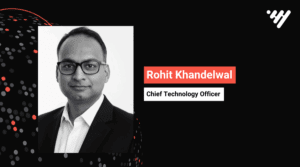Integrating Modern Fintech Solutions with Legacy Systems: Infrastructure Challenges and Opportunities in Capital Markets
November 7, 2025
Posted by Wirason Kongprasonk
Integrating Modern Fintech Solutions with Legacy Systems: Infrastructure Challenges and Opportunities in Capital Markets

By Wirason Kongprasonk, Regional Solutions Manager, ASEAN
Legacy systems form the core of the banking industry. Much of its infrastructure still runs on code written decades ago. In this era of AI-powered software and automated workflows, many legacy institutions and banks continue to rely on old-school, traditional software for their day-to-day operations. The extensive adoption of the internet and the evolution of AI encouraged many financial technology firms like ViewTrade are developing software and technologies to cater to the current market’s requirements. However, integrating legacy systems with modern technologies has its own set of challenges. If done right with meticulous planning and strategizing, fintech integration with legacy systems can be a significant enabler in modern finance. Through this article, we explore some of the common challenges faced while integrating modern technologies with legacy systems and how Fintechs are trying to overcome them.
Why is There a Need to Integrate Modern Fintech Solutions with Legacy Systems?
Legacy systems refer to outdated systems that are still used in traditional financial institutions and banks. Despite the rapid growth of Fintech platforms, legacy systems are still driving core functionalities like trading, clearing and settlement. A lot of core systems in the global financial market run on outdated code bases and batch-processing architectures that struggle to support real-time reporting of market trends, data exchange and regulatory compliance at a speed that current markets demand.
For market participants, these systems are often mission-critical—they are robust, proven, and heavily customized over decades. However, they pose significant limitations:
Integration barriers: Modern APIs are difficult to connect with the inflexible architecture of legacy systems.
Operational silos: Outdated systems are not interconnected, leading to disjointed workflows across departments and forcing people to handle key tasks, like trade reconciliation, manually. It results in slower operations, higher costs, and risk of errors.
Maintenance overhead: Legacy technology is expensive to maintain; at times requiring specialized skills to manage and can be expensive to support over time.
Cybersecurity vulnerabilities: Modern security features are missing from legacy technology. The essential updates may no longer be available, making it more prone to cyber risks.
At ViewTrade, we help organizations modernize their systems without disrupting regular operations. In recent times, we have seen more clients reaching out to us, looking to connect legacy platforms with fintech solutions to stay compliant, move faster, and operate without any glitches.
Fintech Integration as a Strategic Enabler
The evolution of fintech platforms allows capital market participants to gain efficiencies that legacy systems cannot achieve alone. Fintech integration can deliver:
Low-latency trading: Today’s APIs can link older order management systems to alternative liquidity venues, helping firms execute trades faster, process data in real time, and shorten settlement cycles. The result is smoother and more efficient market activity.
Better data integration: Market data and back-office systems can be connected easily with standardised API gateways, thereby improving data flow, reducing manual intervention, and creating a more accurate view across systems.
Faster client onboarding: With digital onboarding and built-in KYC tools, firms can onboard new clients quickly, without compromising on regulatory requirements.
Proactive risk management: Early detection of compliance or operational risks with real-time monitoring tools helps firm avoid risk and cost.
At ViewTrade, we’ve designed our API-first workflows to act as a secure, adaptable bridge. This lets clients connect legacy platforms to newer applications and third-party services without having to overhaul their entire technology stack.
Opportunities in Post-Trade Modernization
One of the most significant areas for transformation lies in post-trade modernization. The shift toward T+1 and eventual real-time settlement require rethinking post-trade workflows to integrate with clearinghouses, custodians, and internal risk systems.
Key opportunities we see include:
Real-time reconciliation: Currently, companies are moving to systems that sync data continuously. With the help of APIs, information can be pulled or pushed from older system in real time. It avoids the need to wait for end-of-day reports.
Automated exception handling: Using AI-driven tools can help in flagging and resolving settlement issues before end-of-day deadlines. This continuous synchronization eliminates information lags and ensures that data across the organization is always current.
Cross-border compliance automation: APIs can embed jurisdiction-specific regulatory rules directly into post-trade workflows.
In our partner ecosystems, we implement solutions that integrate settlement risk monitoring tools with legacy trade capture platforms, ensuring a smoother transition to faster settlement cycles and reducing the risk of manual errors.
Infrastructure Challenges in Capital Markets
While integration offers clear benefits, capital markets participants must navigate complex infrastructural issues:
- System architecture capability between large units and microservice with independent services that can be updated and scaled individually
- Data format inconsistencies between legacy systems and modern APIs.
- Latency mismatch between batch-oriented legacy processes and real-time fintech platforms.
- Cybersecurity risks related to connecting external fintech tools to internal systems.
- Regulatory implications of modifying connectivity in systems certified for compliance.
ViewTrade provides secure API layers to address the above challenges, along with robust encryption protocols and modular workflows that enable phased migration, seamless integration with other platforms, and rapid development at the client’s pace. This helps in minimizing operational risk and ensures compliance across jurisdictions.
The Path Forward: Hybrid Digital Transformation
We believe the most effective approach to digital transformation in capital markets is not wholesale replacement but strategic hybridization, which can help firms achieve:
- Accelerated time-to-market for new products
- Cut down on operational costs through automation
- Greater resilience against market volatility
- Reduce risk and ensure audit-ready data flows
For global brokers and institutions, this hybrid model allows for progressive modernization while safeguarding mission-critical systems, a philosophy that underpins all of ViewTrade’s integration partnerships.
Conclusion
Integrating modern fintech solutions with legacy systems in capital markets infrastructure is an ongoing process that requires technical agility, awareness about regulations and strategic foresight. From post-trade modernization to API-driven workflows, creating an interoperable environment where old-school technologies can work in tandem with modern innovation is where the opportunity lies.
At ViewTrade, we enable capital markets firms to overcome legacy challenges, accelerate innovation, improve operational efficiency. We ensure compliance and enable them to offer superior client experiences. This approach helps our partners to embrace the future without letting go of the systems and processes that have sustained their success for decades.
FAQs
How do API-driven workflows help in digital transformation?
APIs connect different platforms and services seamlessly. It’s encouraging firms to automate operations, improve data exchange, establish consistent security and governance, simplifying compliance management at scale and enhancing client experiences.
What role does post-trade modernization play in capital markets?
Post-trade modernization provide efficient settlements, encourages risk-free cross-border trading, and supports real-time settlement models such as the T+1 settlement schedule. This provides investors access to real-time progress of their trades, making cross-border transactions transparent and fraud-free.
Can legacy systems fully coexist with modern fintech tools?
Yes, but full and seamless coexistence is challenging. Legacy platforms have its own restrictions such as rigid architectures, security vulnerabilities, high maintenance costs, and difficulties meeting real-time data and regulatory demands. Integrating fintech tools depend on APIs, microservices, and cloud technology connections.
How does ViewTrade support fintech integration for its partners?
ViewTrade provides API-driven market access, post-trade connectivity, and digital onboarding solutions. These can be integrated with clients’ existing systems without disruption, thereby helping them modernize and keeping operations flowing and compliant.
What are the security considerations when connecting fintech platforms to legacy systems?
To ensure secure and stable system integration, institutions must use secure APIs, strong encryption, access controls, identity management, and compliance monitoring. These measures help prevent unauthorized access and protect data integrity in line with modern regulations.










